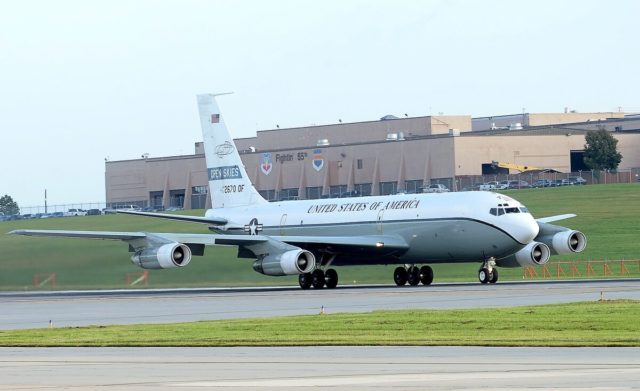
In 1955, President Dwight D. Eisenhower proposed to the Kremlin that the U.S. and the USSR each be permitted to conduct aerial reconnaissance of the other’s territory and collect data on each other’s military forces and activities to enhance confidence that neither was planning a surprise attack. Moscow refused, calling it a license for American spying. Intensification of the Cold War made the issue dormant until President George H.W. Bush revived it in 1999 after the collapse of the Soviet Union. The “Open Skies Treaty” was signed and ratified in 2002 and now has 34 members. According to the Arms Control Association, “All of a state-party’s territory can be overflown. No territory can be declared off-limits by the host nation.” In addition, “Observation aircraft used to fly the missions must be equipped with sensors that enable the observing party to identify significant military equipment, such as artillery, fighter aircraft, and armored combat vehicles.”
President Donald Trump has notified the parties that the U.S. is withdrawing from Open Skies, effective in six months. He did not irrevocably slam the door on the treaty but, as he did with the Intermediate Nuclear Forces (INF) Treaty and the Joint Comprehensive Plan of Action (JCPOA, the “Iran deal”), he made clear that the U.S. would not remain a party to a treaty that does not serve American interests. “Russia didn’t adhere to the treaty. So, until they adhere, we will pull out,” he told reporters.
Amid the customary shrieking — by European countries and Democrats — that accompanies the President’s efforts to align American security policy with American interests, three things should be understood:
- The Russians were cheating in their overflights of the United States
- The Russians were cheating the United States in our overflights of Russian territory
- Satellite technology today can easily replace airplane surveillance
The point was to have confidence in what an adversary’s military disposition is at any given time; surveillance information on civilian assets was not included. Administration officials said, however, that Russia has been using its overflights of American and European territory to identify critical American infrastructure, which would be important for an enemy to disable in a time of war. In August 2017, a Russian plane flew very low over downtown Washington, D.C. and over the Capitol Building. Oddly, it then flew to southern Pennsylvania near the Civil War battlefield at Chambersburg and skimmed a corner of West Virginia. But after the “wiggle,” it flew over a golf course in New Jersey where the President was staying — close to an open threat.
In the other direction, Russia has been restricting Western flights in violation of the treaty, obstructing flights over Moscow, Chechnya, near Abkhazia and South Ossetia, as well as Kaliningrad — home to Russia’s Baltic Fleet, and along the Georgian border. The Russians justify the last one by saying that enclaves of Georgia occupied by Russia in 2008 are separate, independent countries not subject to the treaty.
Less concerned, apparently, by Russian violations than by the American response, Democrats on the Hill denounced the President’s decision, angry that it came during the Wuhan virus pandemic and worried that it would undermine U.S. alliances with European allies who believe the treaty keeps Russia “accountable for its military activities” in the region. “The administration´s effort to make a major change to our national security policy in the midst of a global health crisis is not only shortsighted, but also unconscionable,” wrote congressmen Adam Smith and Eliot Engel, and senators Jack Reed and Bob Menendez.
They made no mention of why the Europeans would rely on a treaty the Russians appear to be violating with impunity, nor of the availability of satellite imagery. And the idea that a medical crisis, even a global one, should keep the U.S. from pursuing its national security aims is a non-sequitur. A country has to handle both sets of obligations.
Senator Tom Cotton, on the other hand, expressed satisfaction with the decision. “The Open Skies Treaty started life as a good-faith agreement between major powers and died an asset of Russian intelligence. For Mr. Putin, the treaty was just another scheme to snatch a military and surveillance advantage over the U.S. and NATO. Further, the treaty was technically defunct, as outdated and irrelevant as the VHS recorder or cassette deck.”
One of the major mistakes the United States made after the demise of the Soviet Union and the end of the Cold War was to treat Russia as if it has been occupied by the communists the same way, say, Poland or Czechoslovakia had been. The Open Skies Treaty was a manifestation of that attitude. But the countries occupied by the USSR have emerged as friends and allies to the United States. Russia, under Vladimir Putin, retains the old Soviet hostility toward the West, making the demise of the treaty essential as a matter of U.S. national security.





